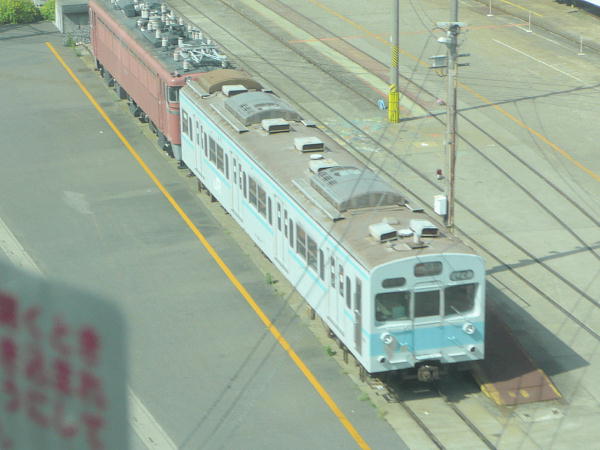301 series on:
[Wikipedia]
[Google]
[Amazon]
The was an
 Following reforming into 10-car sets, the fleet was formed as follows, with car 1 at the Nishi-Funabashi end and car 10 at the Mitaka end. Sets K1 and K2 included former KuHa 301 and KuMoHa 300 driving cars with driving cab equipment removed.
Following reforming into 10-car sets, the fleet was formed as follows, with car 1 at the Nishi-Funabashi end and car 10 at the Mitaka end. Sets K1 and K2 included former KuHa 301 and KuMoHa 300 driving cars with driving cab equipment removed.
 Driving car KuMoHa 300-4 of set K2 is stored at JR East's Omiya Works, removed in 2017.
Driving car KuMoHa 300-4 of set K2 is stored at JR East's Omiya Works, removed in 2017.
electric multiple unit
An electric multiple unit or EMU is a multiple-unit train consisting of self-propelled carriages using electricity as the motive power. An EMU requires no separate locomotive, as electric traction motors are incorporated within one or a numbe ...
(EMU) train type introduced in 1966 by Japanese National Railways
The abbreviated JNR or , was the business entity that operated Japan's national railway network from 1949 to 1987.
Network Railways
As of June 1, 1949, the date of establishment of JNR, it operated of narrow gauge () railways in all 46 pref ...
(JNR), and later operated by East Japan Railway Company
The is a major passenger railway company in Japan and is the largest of the seven Japan Railways Group companies. The company name is officially abbreviated as JR-EAST or JR East in English, and as in Japanese. The company's headquarters are ...
(JR East) on Chuo-Sobu Line and Tozai Line subway through-running services in Tokyo, Japan, until 2003.
Design
Broadly based on the103 series
1 (one, unit, unity) is a number representing a single or the only entity. 1 is also a numerical digit and represents a single unit of counting or measurement. For example, a line segment of ''unit length'' is a line segment of length 1. I ...
commuter EMU, the 301 series was designed specifically for use on through-running services with the Eidan Tozai Line (present-day Tokyo Metro Tozai Line
The is a rapid transit line in Tokyo and Chiba Prefecture, Japan, owned and operated by Tokyo Metro. Its name translates to "''East-West Line"''. The line runs between Nakano in Nakano-ku, Tokyo and Nishi-Funabashi in Funabashi, Chiba Pre ...
) in Tokyo, and was the first aluminium-bodied rolling stock introduced on Japanese National Railways
The abbreviated JNR or , was the business entity that operated Japan's national railway network from 1949 to 1987.
Network Railways
As of June 1, 1949, the date of establishment of JNR, it operated of narrow gauge () railways in all 46 pref ...
(JNR).
When first delivered, the sets were finished with a clear acrylic paint, giving an unpainted appearance. The sets were subsequently painted in light grey with a yellow bodyside stripe. This was later changed to a light blue ("Blue No. 22") stripe to match the Tōzai Line line colour.
For cost reasons, only 56 vehicles were built, and subsequent rolling stock built for Tozai Line through-running services was conventional steel-bodied 103-1200 series stock.
Operations
The 301 series trains were based at Mitaka Depot in Tokyo throughout their service life, and were used on Chūō-Sōbu Line local and Tozai Line subway through-running services.Formations
 Following reforming into 10-car sets, the fleet was formed as follows, with car 1 at the Nishi-Funabashi end and car 10 at the Mitaka end. Sets K1 and K2 included former KuHa 301 and KuMoHa 300 driving cars with driving cab equipment removed.
Following reforming into 10-car sets, the fleet was formed as follows, with car 1 at the Nishi-Funabashi end and car 10 at the Mitaka end. Sets K1 and K2 included former KuHa 301 and KuMoHa 300 driving cars with driving cab equipment removed.
Sets K1–2
Cars 2, 4, 7, and 9 were each equipped with one lozenge-type pantograph.Sets K3–5
Cars 2, 4, 7, and 9 were each equipped with one lozenge-type pantograph. SaHa 301-101 was modified from former MoHa 301-4, and retained the original pantograph mounting points.Interior
Seating consisted of longitudinal bench seating throughout. Compared with the 103 series seating, seat width was increased by to per person.History
The 301 series were delivered in 1966 to Mitaka Depot in Tokyo, initially formed as eight 7-car sets. From 1981, the fleet was reformed into 10-car sets with the creation of SaHa 301 trailer cars converted from former MoHa 300 and MoHa 301 motored cars. As of 1 April 2002, 50 vehicles (5 x 10-car sets) remained in service, but the fleet was subsequently replaced by new E231-800 series EMUs and withdrawn during 2003. A special ''Sayonara 301 series'' train was run by JR East on 3 August 2003.Preserved examples
 Driving car KuMoHa 300-4 of set K2 is stored at JR East's Omiya Works, removed in 2017.
Driving car KuMoHa 300-4 of set K2 is stored at JR East's Omiya Works, removed in 2017.
References
{{JR East EMU Electric multiple units of Japan East Japan Railway Company Train-related introductions in 1966 Kawasaki multiple units Nippon Sharyo multiple units 1500 V DC multiple units of Japan